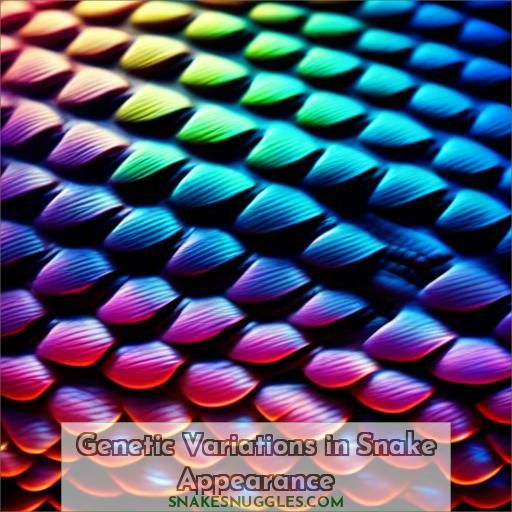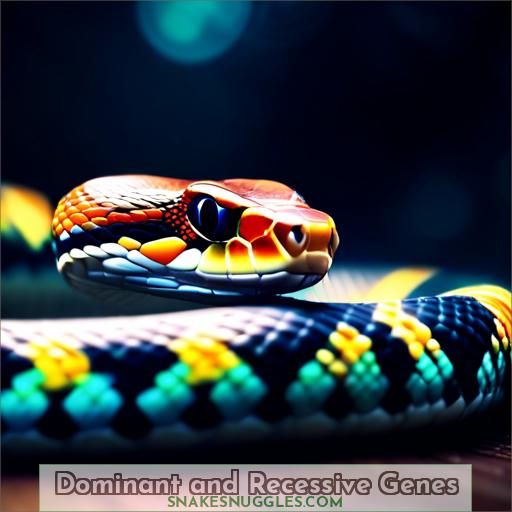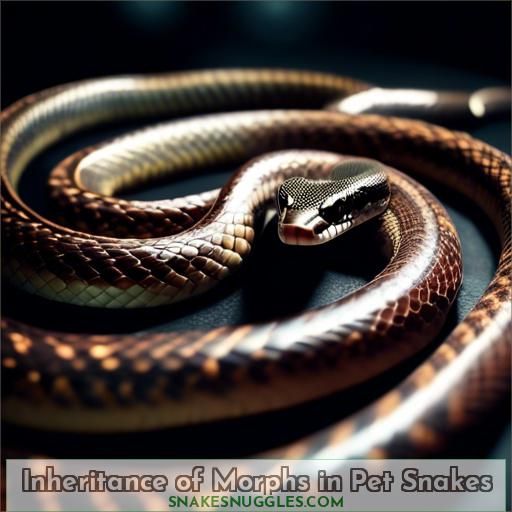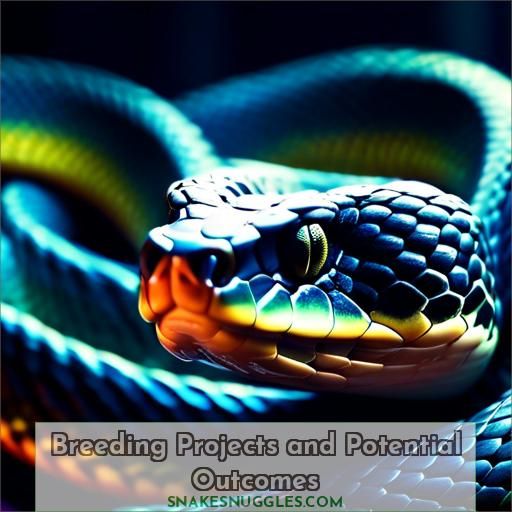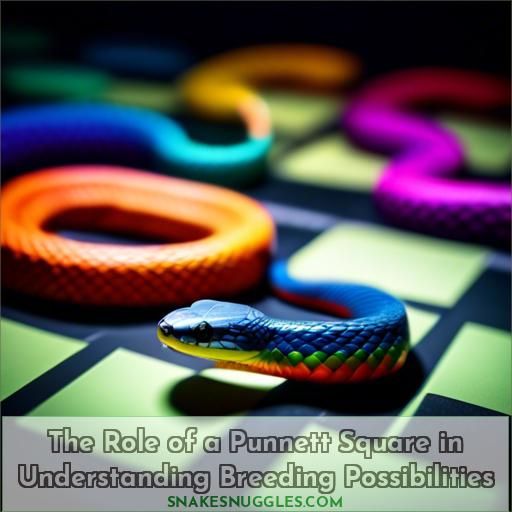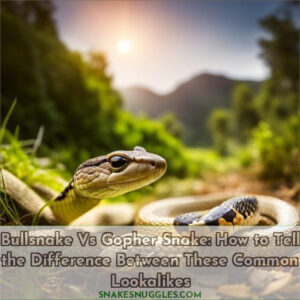This site is supported by our readers. We may earn a commission, at no cost to you, if you purchase through links.
 You’re about to dive into the captivating world of snake morphs! Genetic variations like albinism, melanism, and axanthism create an array of striking patterns and colors. Dominant and recessive genes, along with complex inheritance mechanisms like codominance and epistasis, influence a snake’s appearance.
You’re about to dive into the captivating world of snake morphs! Genetic variations like albinism, melanism, and axanthism create an array of striking patterns and colors. Dominant and recessive genes, along with complex inheritance mechanisms like codominance and epistasis, influence a snake’s appearance.
Selective breeding allows reptile enthusiasts to produce desired morphs by strategically combining traits. Punnett squares become invaluable tools for predicting offspring outcomes. But this is just the surface – let’s explore the intricacies of snake morphs and unlock the secrets behind creating and maintaining these mesmerizing reptilian wonders.
Table Of Contents
- Key Takeaways
- Genetic Variations in Snake Appearance
- Dominant and Recessive Genes
- Inheritance of Morphs in Pet Snakes
- Breeding Projects and Potential Outcomes
- The Role of a Punnett Square in Understanding Breeding Possibilities
- Frequently Asked Questions (FAQs)
- What is the difference between a morph and a mutation in snakes?
- How do snake morphs affect the snake’s quality of life?
- Can you explain the role of a Punnett Square in understanding breeding possibilities for snake morphs?
- What are the most common genetic issues associated with snake morphs?
- How do breeders ensure the health and well-being of snakes with genetic disorders?
- Conclusion
Key Takeaways
- Snake morphs are influenced by multiple genes, each with a small effect on the phenotype, leading to complex inheritance patterns.
- Sex-linked inheritance can lead to sex-specific patterns of inheritance, where certain traits are more likely to be expressed in one sex over the other.
- Incomplete dominance and codominance can result in a wide range of morphs, as the expression of the trait isn’t strictly determined by the presence or absence of a particular allele.
- The role of a Punnett square in predicting offspring outcomes is essential for understanding breeding possibilities and making informed pairing decisions.
Genetic Variations in Snake Appearance
Dive into the kaleidoscope of snake skins, where polygenic traits paint each scale with precision.
Imagine the genetic brushstrokes that create albino snakes, their scales void of color, a masterpiece of genetics.
Or consider hypomelanism, a subtle dimming of hues, like turning down the saturation on a vivid photograph.
Axanthism and xanthism are the yin and yang of coloration, one stripping away yellows, the other amplifying them, showcasing nature’s palette.
This genetic lottery isn’t just a roll of the dice; it’s a carefully shuffled deck, where each hand dealt reveals a new combination of beauty.
Dominant and Recessive Genes
Dive into the genetic basis of snake morphs and you’ll find yourself navigating the complexities of allelic interactions and phenotypic expression. These interactions determine the appearance of a snake, whether it’s a vibrant ball python or a sleek corn snake. Understanding the genetic makeup of these creatures is crucial for breeders, as it underpins the inheritance of morphs in pet snakes.
Dominant and recessive genes play a pivotal role in this realm. Dominant genes are the ones that show up when an individual is homozygous for the trait, while recessive genes are only expressed when an individual is homozygous for the recessive allele. Codominance, on the other hand, is when both alleles contribute to the phenotypic expression of a trait.
Breeding projects are designed to enhance these genetic traits, but it’s not merely a matter of crossing two snakes with desirable morphs. The potential outcomes are ever-evolving and can be influenced by a multitude of factors, from environmental conditions to the specific alleles involved.
In the heart of this everchanging world, a Punnett square can be your compass, helping you unveil the secrets of breeding possibilities. It’s advisable to consult with experts in the field, as the realm of snake morphs isn’t only complex but also daunting for those new to the scene.
Inheritance of Morphs in Pet Snakes
Inheriting Morphs in Pet Snakes: Navigating the Complexities
When it comes to pet snakes, understanding the inheritance patterns of morphs can be a daunting task. However, armed with knowledge of genetics, we can unlock the secrets of how these traits are passed down from one generation to the next. In this section, we’ll delve into the intricacies of polygenic inheritance, sex-linked inheritance, and the role of incomplete dominance, codominance, and epistasis in shaping the morphs we see in our beloved pets.
First, let’s discuss polygenic inheritance. This type of inheritance is characterized by the presence of multiple genes, each with a small effect on the phenotype. For instance, the coloration of a snake can be influenced by several genes, each contributing a small part to the final appearance. This means that the inheritance of morphs in pet snakes can be more complex than a simple dominant-recessive pattern.
Sex-linked inheritance is another important factor to consider. In many snakes, the sex chromosomes aren’t homomorphic, meaning they differ between males and females. This can lead to sex-specific patterns of inheritance, where certain traits are more likely to be expressed in one sex over the other. For example, in some species, the sex chromosomes may carry genes that influence coloration or pattern, leading to sex-specific morphs.
Incomplete dominance is a genetic phenomenon where the heterozygous individual (carrying one dominant and one recessive allele) exhibits a phenotype that’s intermediate between the homozygous dominant and homozygous recessive individuals. This can result in a wide range of morphs, as the expression of the trait isn’t strictly determined by the presence or absence of a particular allele.
Codominance, on the other hand, occurs when both alleles of a gene are equally expressed in the phenotype. This can lead to a wider range of morphs, as the combination of different alleles can result in unique expressions of the trait.
Finally, epistasis is a genetic interaction where the expression of one gene is influenced by the presence of another gene. In the context of snake morphs, this can lead to complex inheritance patterns, where the expression of one trait is dependent on the presence of another.
Understanding these genetic concepts can help us better predict the outcomes of breeding projects in pet snakes. By using tools like Punnett squares, we can visualize the possible combinations of genes and their effects on the phenotype. This can be invaluable in designing breeding strategies aimed at producing specific morphs or combinations of traits.
Breeding Projects and Potential Outcomes
Breeding projects in the world of pet snakes are a complex and ever-evolving realm of selective breeding, crossbreeding, and line breeding. These techniques are designed to enhance genetic diversity and unveil the secrets of phenotypic expression. Selective breeding is a method where breeders choose specific traits to breed for, such as color patterns or size. Crossbreeding involves breeding two different species or morphs together to create a new hybrid. Line breeding, on the other hand, involves breeding closely related snakes to maintain or accentuate certain traits.
The potential outcomes of these breeding projects can be daunting, as they often involve navigating the complexities of genetic inheritance. For example, a breeder might cross a ball python with a corn snake to create a new morph with the desirable traits of both species. However, this process can also lead to unintended consequences, such as health issues or undesirable traits.
It’s not merely about creating a bespoke or tailored snake for your collection; it’s about understanding the genetic underpinnings of these creatures and working towards enhancing their overall well-being. In the heart of this endeavor lies the goal of unlocking the secrets of genetic inheritance and the ever-changing world of snake morphs.
The Role of a Punnett Square in Understanding Breeding Possibilities
As we delve deeper into the world of snake breeding, it’s crucial to understand the role of a Punnett Square in predicting offspring outcomes.
This tool is designed to enhance our understanding of allele combinations.
It is an essential part of the breeding process.
By meticulously navigating the complexities of homozygous vs heterozygous alleles, we can predict the genetic diversity of our offspring.
The Punnett Square underpins the ever-evolving realm of breeding projects.
It helps us tailor our efforts towards specific outcomes.
It’s not merely a tool for predicting offspring.
It’s a robust means of unlocking the secrets of genetic inheritance.
So, when it comes to understanding breeding possibilities, the Punnett Square is your bespoke guide.
It is designed to enhance your journey in the heart of this ever-changing and ever-evolving world.
Frequently Asked Questions (FAQs)
What is the difference between a morph and a mutation in snakes?
A morph results from selective breeding, while a mutation is a natural, random genetic change. Breeders purposefully create morphs, but mutations occur spontaneously without human intervention. With snakes, desired mutations are then selectively bred to establish new morphs.
How do snake morphs affect the snake’s quality of life?
Picture a kaleidoscope of colors winding gracefully. Morphs give snakes vibrancy–zero health drawbacks. They thrive, radiating unique beauty.
Can you explain the role of a Punnett Square in understanding breeding possibilities for snake morphs?
A Punnett Square visually maps out all possible gene combinations when breeding snakes. You can predict morph odds and make informed pairing decisions to achieve desired traits.
What are the most common genetic issues associated with snake morphs?
Roughly 80% of snake morphs face issues like neurological problems, dwarfism, and jaw abnormalities. These genetic flaws often lead to major health complications, so careful breeding practices are crucial.
How do breeders ensure the health and well-being of snakes with genetic disorders?
Ethical breeders prioritize genetic testing, prevent inbreeding, cull deformed snakes humanely, and focus on improving overall species health.
Conclusion
Like navigating a labyrinth, understanding snake morphs and their breeding intricacies requires a keen eye and meticulous planning. By mastering genetic inheritance, punnett squares, and potential outcomes, you’ll unlock a realm of possibilities in creating bespoke reptilian wonders that captivate enthusiasts worldwide.

